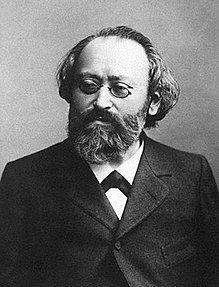
The cello ( CHEL-oh; plural cellos or celli) or violoncello ( VY-ə-lən-CHEL-oh; Italian pronunciation: [vjolonˈtʃɛllo]) is a string instrument. It is played by bowing or plucking its four strings, which are usually tuned in perfect fifths an octave lower than the viola: from low to high, C2, G2, D3 and A3. It is the bass member of the violin family, which also includes the violin, viola and the double bass, which doubles the bass line an octave lower than the cello in much of the orchestral repertoire. After the double bass, it is the second-largest and second lowest (in pitch) bowed string instrument in the modern symphony orchestra. The cello is used as a solo instrument, as well as in chamber music ensembles (e.g., string quartet), string orchestras, as a member of the string section of symphony orchestras, most modern Chinese orchestras, and some types of rock bands.

Isaac Stern was an American violinist.

Max Christian Friedrich Bruch, also known as Max Karl August Bruch, was a German Romantic composer and conductor who wrote over 200 works, including three violin concertos, the first of which has become a staple of the violin repertory.

A piano concerto is a type of concerto, a solo composition in the Classical music genre which is composed for a piano player, which is typically accompanied by an orchestra or other large ensemble. Piano concertos are typically virtuoso showpieces which require an advanced level of technique on the instrument, including melodic lines interspersed with rapid scales, arpeggios, chords, complex contrapuntal parts and other challenging material. When piano concertos are performed by a professional concert pianist, a large grand piano is almost always used, as the grand piano has a fuller tone and more projection than an upright piano. Piano concertos are typically written out in music notation, including sheet music for the pianist, orchestra parts for the orchestra members, and a full score for the conductor, who leads the orchestra in the accompaniment of the soloist.

Friedrich "Fritz" Kreisler was an Austrian-born violinist and composer. One of the most noted violin masters of his day, and regarded as one of the greatest violinists of all time, he was known for his sweet tone and expressive phrasing. Like many great violinists of his generation, he produced a characteristic sound which was immediately recognizable as his own. Although it derived in many respects from the Franco-Belgian school, his style is nonetheless reminiscent of the gemütlich (cozy) lifestyle of pre-war Vienna.

Gregor Piatigorsky was a Russian-born American cellist.

Selim Gustaf Adolf Palmgren was a Finnish composer, pianist, and conductor. Palmgren was born in Pori, Finland, February 16, 1878. He studied at the Conservatory in Helsinki from 1895 to 1899, then continued his piano studies in Berlin with Ansorge, Berger and Busoni. He conducted choral and orchestral societies in his own country and made several very successful concert tours as a pianist in the principal cities of Finland and Scandinavia, appearing also as a visiting conductor. In 1921, he went to the United States, where he taught composition at the Eastman School of Music, later returning to Finland, where he died in Helsinki, aged 73.
Gaspar Cassadó's Cello Concerto in D minor was first performed in 1926 by Cassadó and Pablo Casals, to whom the work was dedicated.
This Suite, like the Cello Concerto and the Piano Trio, came from one of Gaspar Cassadó's most prolific periods, in the mid-1920s.
Boccherini's Cello Concerto No. 2 in A major, G. 475 naturally takes the back seat to the Friedrich Grützmacher ever-famous arrangement of the B-flat Concerto. But no less attention was given to the A Major Concerto. This Concerto was arranged and reorchestrated by at least a half a dozen hands: Ottorino Respighi and Gaspar Cassadó are the most noted. Resphighi reorchestrated the Concerto, and changed the "Tutti" sections; adding winds and brass. Cassadó, on the other hand, rewrote the Concerto altogether. He wrote a Guitar Concerto for his colleague Andrés Segovia. Cassadó's arrangement features a string quartet, like a Concerto Grosso; and trumpet fanfares give the Concerto a Rodrigian feel.

The Cello Concerto of Pyotr Ilyich Tchaikovsky is a conjectural work based in part on a 60-bar fragment found on the back of the rough draft for the last movement of the composer's Sixth Symphony, the Pathétique. In 2006, Ukrainian composer and cellist Yuriy Leonovich completed the work.

Alisa Weilerstein is an American classical cellist. She was named a 2011 MacArthur Fellow.
Raphael Wallfisch is an English cellist.
Siegfried Palm was a German cellist who is known worldwide for his interpretations of contemporary music. Many 20th-century composers like Kagel, Ligeti, Xenakis, Penderecki and Zimmermann wrote music for him. He was also Rektor of the Hochschule für Musik Köln and Intendant of the Deutsche Oper Berlin.
The Violoncello Concerto Op. 91 composed by Franco Margola is one of his most important works. Dedicated to the Spanish cellist Gaspar Cassadó the concerto "came to exist in three different versions from which Margola drew the material for the definitive final version in 1949, having also benefited from the advice of the dedicatee Cassadó".
The Minuet in G, Op. 14/1, is a short piano composition by Ignacy Jan Paderewski, which became world-famous, overshadowing his more major works such as the Symphony in B minor "Polonia", the Piano Concerto in A minor, and the opera Manru. The John Philip Sousa band performed a transcription of the piece in Rochester, NY on November 12, 1894..










